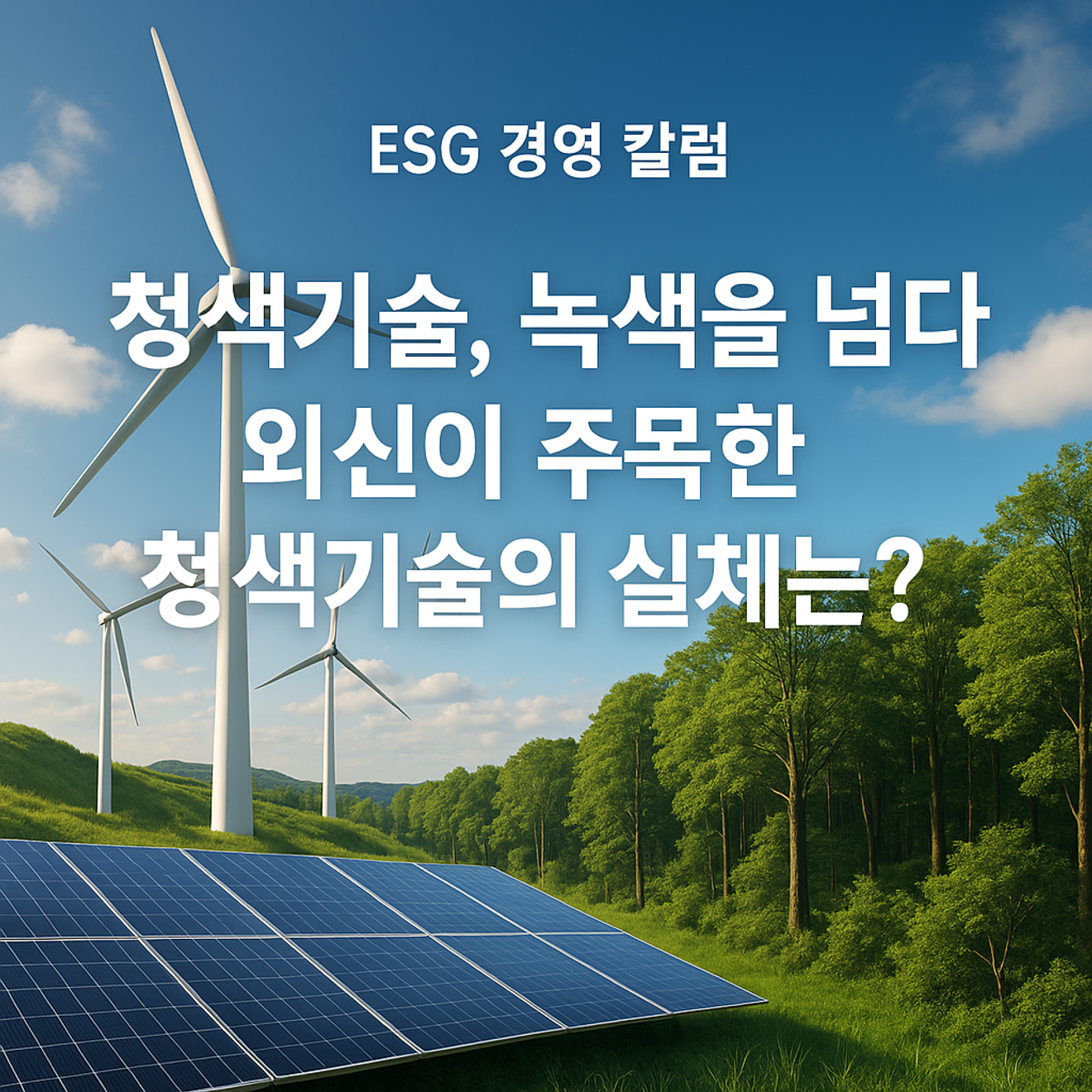Subject
- #Sustainable Technology
- #ESG Management
- #ESG Transition
- #Green Technology
- #Blue Technology
Created: 2025-05-24
Created: 2025-05-24 14:56

Blue Technology, Beyond Green – A Turning Point in ESG Transition
[ESG Management Column] ① Blue Technology, Beyond Green – The Turning Point of ESG Transition
Columnist Choi Bong-hyuk (Director, Korea Purchasing and Procurement Society)
In the era of responding to the climate crisis, ESG management is no longer an option but a survival strategy. In this trend, there is a new concept of technology that has recently attracted attention. It is ‘Blue Technology’. In particular, foreign media and global policy reports are clearly distinguishing this concept from Green Tech by dealing with this concept with various expressions such as ‘Blue Innovation’ and ‘Blue Economy’.
So, is ‘Blue Technology’ just a buzzword, or an alternative technology for the ESG era? It is time for a fact-based check based on foreign media and international reports.
■ The ‘blue’ keyword is increasing rapidly in foreign media… Is it a sign of ESG expansion?
The mention of ‘Blue Technology’ has noticeably increased in major economic journals in the United States and Europe over the past year. The New York Times, Financial Times, and Bloomberg Green all commonly point out that “The carbon reduction-centered strategy of existing green technology has reached its limit”and explain ‘Blue Technology’ as a fusion technology centered on natural resilience.
In particular, the European Union (EU) expanded Blue Technology to a ‘sustainable ecosystem recovery-based strategy’ for not only the ‘Blue Growth Strategy’ in 2023 but also sustainable technologies in general. This can be understood as a strategy that goes beyond simple environmentally friendly designs, where technology imitates or adapts to nature and enhances resilience.
■ Blue Technology ≠ Marine Technology… Between misunderstanding and establishment
In Korea, Blue Technology is often confused with ‘blue carbon (marine carbon sink)’ or ‘marine industry’. However, it is defined in a much broader sense in foreign media and UN reports. For example, the National Oceanic and Atmospheric Administration (NOAA) defines Blue Technology as follows.
“Blue Technology is a technology that utilizes the principles of nature or preserves natural ecosystems, and is a sustainable technology that integrates energy conservation, biomimicry, and resource circulation.”
– NOAA, 2022 Policy Briefing
Therefore, the equation ‘Blue Technology = Marine Technology’ is an excessive reduction, and conversely, the interpretation ‘all eco-friendly technology = Blue Technology’ is too broad. The exact concept is summarized as ‘ecologically adaptive fusion technology’.
■ Where is the application point of Blue Technology in ESG management?
Analyzing foreign media reports, Blue Technology is evolving into a technological philosophy that can encompass even ‘G (Governance)’ beyond ‘E (Environment)’ among the three pillars of ESG. In particular, Blue Technology, which reflects biomimicry, energy saving, and waste minimization in the entire product production process, can contribute to securing the sustainability of the entire supply chain even more than existing eco-friendly technologies.
For example, Bloomberg Green reports as follows.
“Blue Technology is not just replacing ‘green’, but rather appears in the form of embedding the fundamental principles of ethical control, ecological responsibility, and sustainable design in technology in ESG.”
– Bloomberg Green, November 22, 2023
In this respect, Blue Technology is not just an environmental technology, but is establishing itself as a technological philosophy with strategic consistency with the ESG evaluation system.
■ Why Blue Technology is needed: ‘Limitations and Saturation’ of Green Technology
Most existing green technologies are designed with a focus on carbon emission reduction and renewable energy. However, there are also cases where they conflict with fundamental sustainability, such as the use of non-recyclable materials and the application of technologies that burden the ecosystem.
According to the ‘Green Deal Technical Impact Assessment Report (2023)’ under the EU Commission, some green technologies are producing adverse effects by causing new environmental burdens (waste materials, excessive energy consumption, etc.) rather than improving the environment. The concept that arose in this background is Blue Technology.
Blue Technology focuses on “a design strategy where technology does not resist nature but harmonizes with it”, which is in line with the philosophy of emphasizing reliability and long-term value in ESG management.
■ Conclusion: Blue Technology is ‘Technological Honesty’ in the ESG Era
Blue Technology is still in its early stages of concept establishment. However, if we combine overseas policy reports, corporate ESG evaluation criteria, and technology ethics discussion trends, it is evolving into a strategy that is not just a buzzword but ‘implements the philosophical basis of ESG management in technology’.
If green technology is a technology of ‘reduction’, blue technology is a technology of ‘harmony and recovery’.
This is not just a matter of technology, but a matter of what values and philosophies we will incorporate into the industry in the future.
As an independent media outlet, the conditions for direct coverage are limited, but even with fact-based analysis through refined reports from major overseas media and international organizations, it is possible to lead to a substantial discussion.
Blue technology is a technology that enables ‘sustainable choices’, not an option.
Source
New York Times, “Blue Innovation in ESG Investing” (2023.07)
Bloomberg Green, “Tech Beyond Carbon: The Rise of Blue” (2023.11.22)
Financial Times, “Circular Technology and Ecological Intelligence” (2023.09)
EU Commission, Blue Growth Strategy 2023
NOAA (National Oceanic and Atmospheric Administration), Blue Tech Briefing, 2022
UNEP, Sustainable Blue Economy Report, 2022
European Commission, Green Deal Technical Impact Report, 2023
Comments0